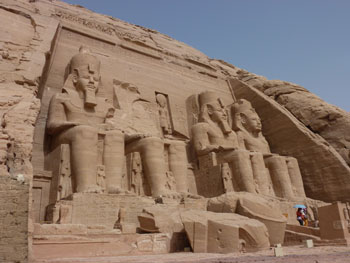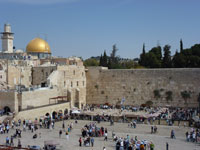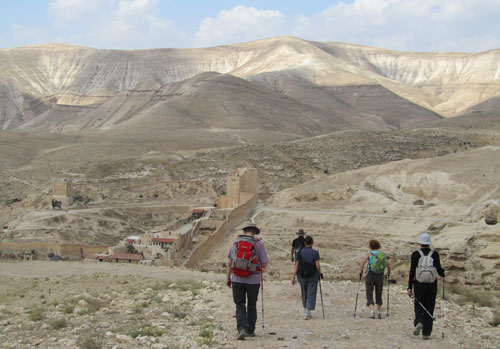Petra - 200 years of exploration
It’s been 200 years since Petra was “re-discovered” by Jean-Louis ‘Ibrahim’ Burckhardt, the first European in modern times to explore the ancient city. In 1812, the Swiss explorer, travelling in disguise and under an adopted Islamic name, heard rumours of fantastic ruins and briefly explored the city with a local guide. Since then the accolades have flowed for Petra, becoming a world heritage site in 1985 and one of the new wonders of the world in 2007, in addition to gaining Hollywood stardom. Despite this Petra, the ‘rose red city, half as old as time’, remains as exhilarating an experience for first time visitors today as it surely was for Burckhardt 200 years ago.

Petra was built by a civilisation known as the Nabataeans, a nomadic tribe of traders who settled in the area in the 6th century BCE. Growing wealthy from their strategic position along the spice and incense routes, the Nabataeans built this spectacular city over several centuries. Realising that their skills and the environment were more conducive to sculpture than architecture, they became expert rock carvers of the soft sandstone rock of Petra, leaving a legacy perhaps only matched at Lalibela in Ethiopia. Lacking a distinctive architectural heritage of their own, the Nabataeans borrowed from Egyptian, Hellenistic, Assyrian and Mesopotamian styles whilst Roman influences became more pronounced after they assumed control of the empire in the 2nd century CE. Earthquakes in the 4th and 6th centuries destroyed much of the city and Petra became the archetypal ‘Lost City’, whose secret was kept by local Bedouin. It is an irony of history that a people missing from most historical textbooks should have left one of the greatest physical legacies for future generations.
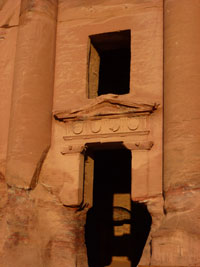
The extraordinary nature of Petra, combined with its status and location in a (still) relatively peaceful and stable country, means the site is extremely popular. Despite this, Petra doesn’t feel as crowded or over-commercialised as some of the other major world travel attractions. Perhaps this is due to the sheer scale of the old city which allows it to accommodate visitors in great numbers without overcrowding the main sites. It’s also very easy to have a much quieter, even intimate, experience of Petra by stepping off the main trail and heading to one of the high places. The charm of the local Bedouin who run the souvenir stalls or offer “taxi” rides on donkeys or camels also adds to the Petra experience, rather than being an unwanted distraction as in many other popular destinations.
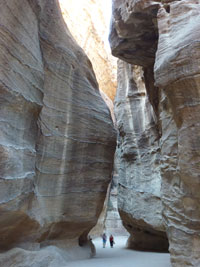
Petra’s most famous site is of course the Treasury facade and the extraordinary Siq canyon that leads to it. No matter how often you’ve seen the Siq in pictures or films, nothing can prepare you for this astonishing spectacle in person. The Siq was formed when a single rock was torn apart by tectonic forces, rather than a gorge formed by water erosion as commonly thought. 1.2km long, it reaches heights of 200 metres and in places is only two metres wide. It’s the combination of such a natural wonder as the Siq with the man-made spectacle beyond that makes Petra such a special destination.
Perhaps only Machu Picchu can rival Petra for a spectacular approach to, and reveal of, an extraordinary historical structure. The approach to the Treasury along the Siq is considerably shorter than the Inca Trail, taking no more than 30 minutes, but no less special because of it. As you proceed along the Siq, the sense of excitement grows as its end draws near until finally, through the narrowest chasm, that light pink facade appears. Although you won’t experience the splendid isolation or awestruck surprise that Burckhardt (or indeed Indiana Jones!) must have felt, the first reveal of the Treasury is an unforgettable moment. Carved from the sandstone rock to serve as a tomb for the Nabataean King Aretas III, the Treasury or Al-Khazneh is a breathtaking sight, a testament to the skill of the Nabataean craftsmen who constructed it and astonishingly well preserved for two millennia. The Treasury is captivating and you could stare at its 43 metre high facade for hours, but don’t stay too long – this is only the beginning.
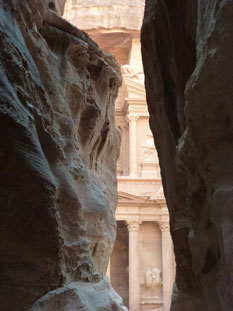
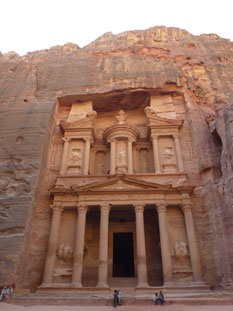

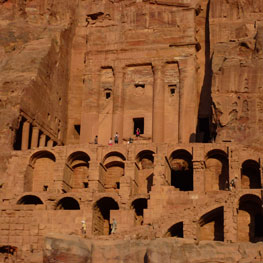
There are two other main groups of historical sites at Petra. Immediately after the Treasury the wadi widens and reveals a series of increasingly impressive Royal Tombs on the rock faces. The tombs can be reached and explored from a series of steps from the wadi floor. The most impressive is perhaps the Urn Tomb (right), characterised by a large, well-preserved facade, vast, naturally-patterned interior and fronted by a wide open terrace which is flanked with a rock-cut portico. Located on vaults which were later added by the Byzantines, the terrace provides a great viewing platform towards the centre of Petra. The nearby Palace Tomb has the largest facade in Petra, though it is badly decayed in several sections. Across from the tombs lies Petra’s Theatre, whose layers of seats were carved from the rock face. Originally built by the Nabataeans, it was renovated and enlarged by the Romans.
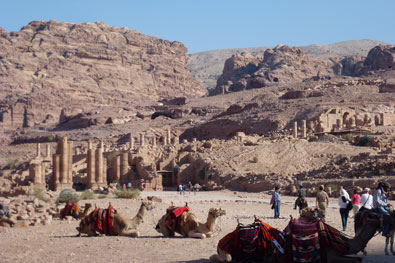
Further along the wadi lies the area known as Petra City Centre which displays more pronounced Roman influences. Centred along a classic Roman colonnaded street, it was the site of the market area and royal palace, though little remains of these. More impressive today are the excavated remains of two temples – the Great Temple and the free-standing Qasr al-Bint. After all this exploration, the two restaurants at the end of the street are a welcome relief – rest and refuel, because that’s just the standard tour group route. If you really want to get to the heart of Petra and fully explore this extraordinary site, read on.

The Monastery
“If you don’t go to the Monastery, then you haven’t really seen Petra” said one of the local Bedouin while we were appreciating the view of the Treasury from the high lookout. A slight exaggeration perhaps, but you can appreciate his point. The Monastery is simply the pinnacle of Petra, an extraordinary rock-carved facade in similar style to the Treasury but far grander in scale. Located at the far end of Petra, it requires a tough, 800 step hike to reach it from the Museum at Petra City Centre. Unlike the Treasury, there is no grand reveal at the end of this trek – instead you suddenly find yourself in a vast open space with the Monastery behind you. Directly opposite is one of the world’s best located cafes, offering rest from the hike and a majestic view of the Nabataean’s crowning achievement.
High Places
The route along Wadi Musa from the Siq to the Museum is Petra’s main thoroughfare, filled with tour groups and other visitors, vendors and camels, donkeys and their owners. To get a different view and feel of the site, a trek to one of the high places is a must. These are tough but manageable hikes and can be fitted in to most visits to Petra. Two of the best are:
High Place of Sacrifice
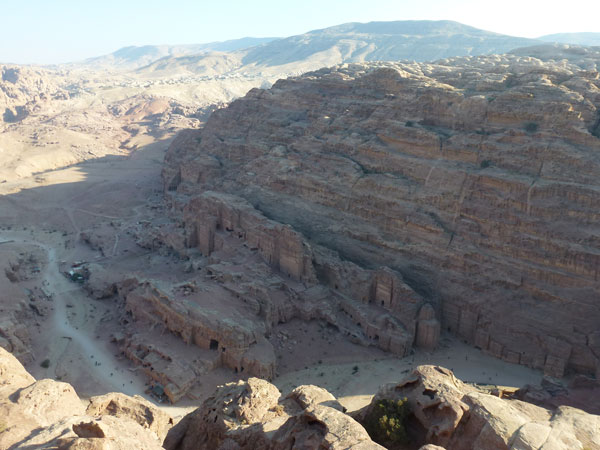
The High Place of Sacrifice was a flattened platform created atop Jebel Madbah which was used for ritual animal sacrifices by the Nabataeans. It can be reached by a 45 minute hike starting near the Theatre. Look for the two astonishing Obelisks at the site entrance, over 6 metres high and carved entirely from the ground rock. Also walk beyond the altar to the edge of the escarpment where there is a superb, bird’s eye view of the Royal Tombs and wadi below (above).
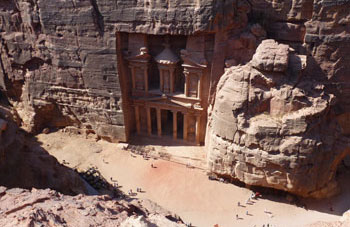
Treasury Lookout
The Treasury is one of Petra’s highlights, but in a confined and often crowded space it can be difficult to fully appreciate its wonder. For a different perspective, hike to the spectacular lookout 200 metres above. Starting beyond the Palace Tomb, a steep series of steps takes you to a flattened hilltop (with excellent views of the Theatre at one point). Continue south through a dirt path until you get right to the edge of the lookout. Your reward is the best view of one of the world’s most iconic historical sites.
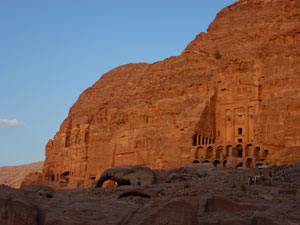
Time
As with many attractions, Petra is best viewed at the start and end of the day. Not only will you avoid the bulk of the crowds and tour groups but many of the monuments at Petra come alive under the sunlight of dawn or dusk. In particular, the Treasury is sunlit in the early morning and the Royal Tombs look spectacular in the golden light of sunset (left). If you’re going to enjoy Petra these times, then you’re going to have to stay more than one day. Frankly you should in any case. The vast scale of Petra warrants extensive exploration and to do it justice requires at least two visits. Also, if you’re visiting from Israel, an overnight stay reduces the ticket price at Petra from 90 to 55 dinars.
Petra by Night
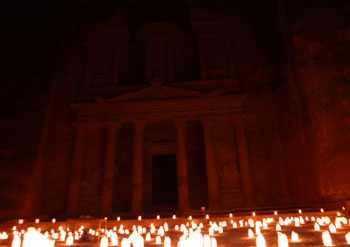
If you want a completely different experience of the Siq and the Treasury, then the Petra by Night tour is a must. At 8.30pm visitors walk through the dark Siq lit only by moonlight and about 1500 lanterns (candles in brown paper bags) and proceed to the Treasury, bathed in the candlelight of hundreds more lanterns at its base. Once there, local Bedouin play traditional music and tell stories of Petra while you sit and appreciate one of the world’s great sights in a magical setting. Be warned though, Petra by Night is extremely popular – try to get there early for a relatively quiet walk through the Siq and a good spot at the Treasury. It can be so overcrowded that much of the time will be spent seating latecomers as they arrive. You’ll also have to put up with the endless futile attempts of amateur photographers to somehow capture the scene with flash photography (hint: it won’t work) and others spoiling the Siq walk with torches (at a site which is testament to mankind’s genius, this stupidity perhaps provides some balance!). Petra by Night runs on Mondays, Wednesdays and Thursdays and costs 12 dinars.
As beguiling today as it must have been 200 years ago, Petra is one of the world’s great historical sites, a fitting testament to this ancient civilisation and one of the great travel experience for today’s. In a world of hyperbole and endless must-see lists, this ‘rose red city, half as old as time’ is a truly spectacular destination that should be on the itinerary of all adventure travellers.
For more information on travel to Jordan, see our country guide.
I visited Petra on an overnight tour from Israel with Abraham Tours, see
details of this tour.
Related articles:
|
There's never been a better time to explore the wonders of ancient Egypt on a trip along the Nile Valley |
Two captivating and contrasting highlights of Israel - the fascinating old city of Jerusalem and the stunning landscapes of the Negev Desert. |
|
Our guide to one of the greatest Roman sites in the world, renowned for its spectacular Library of Celsus and Great Theatre. |
Warm welcomes, beautiful landscapes and surprising diversity on a new Wild Frontiers walking trip in the historic land of Palestine |
Comments
Lisa, My daughter visited Egypt and Jordan two summers ago as part of school trip. Her memories (and photos) of Petra are stunning. How wonderful for you to have had this experience, especially on your birthday, and (double-especially) during a historic political uprising. Glad you made it home safely.
Denis - http://www.facebook.com/profile.php?id=100003425178321 23rd Apr 2013
Submit a comment on this article




